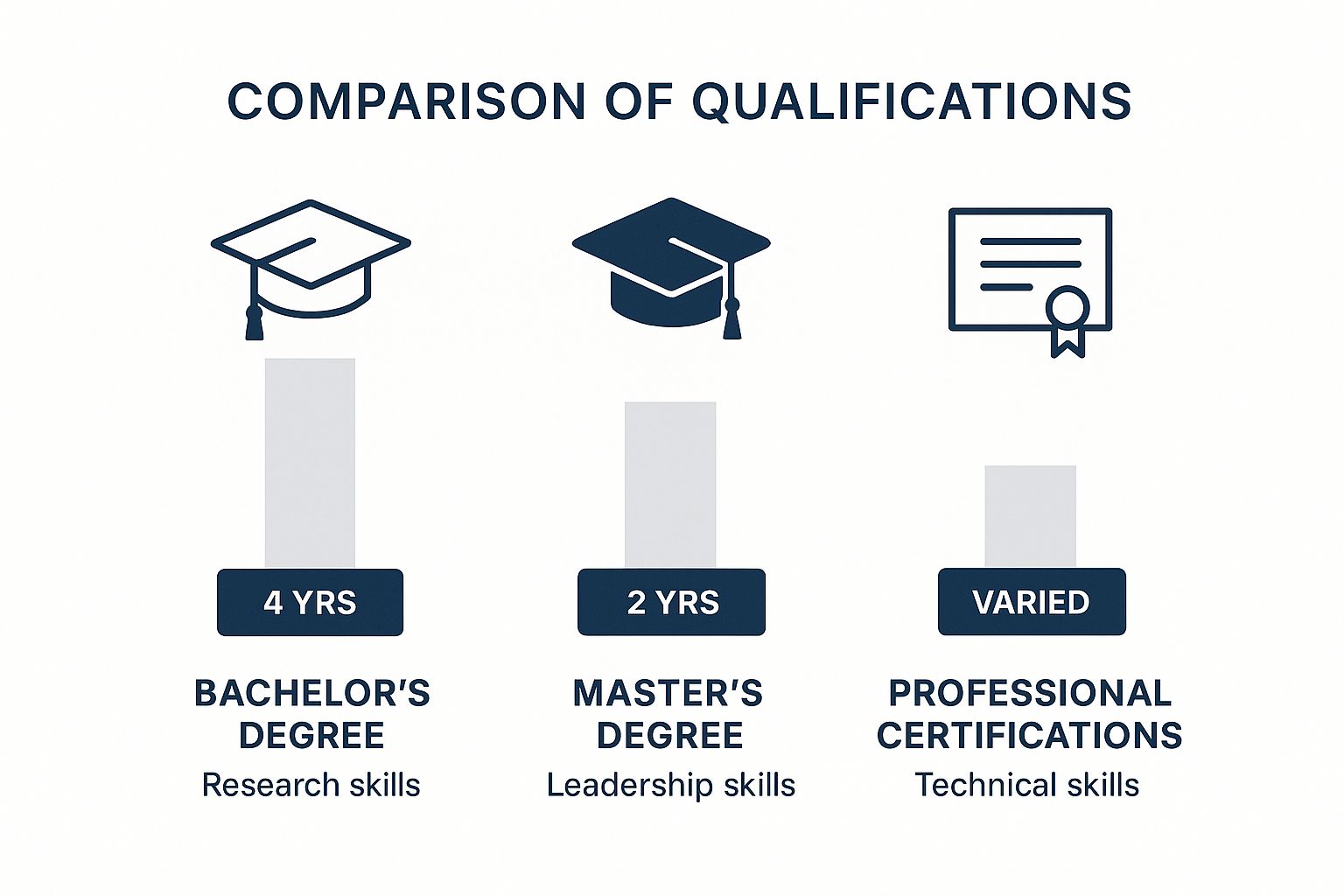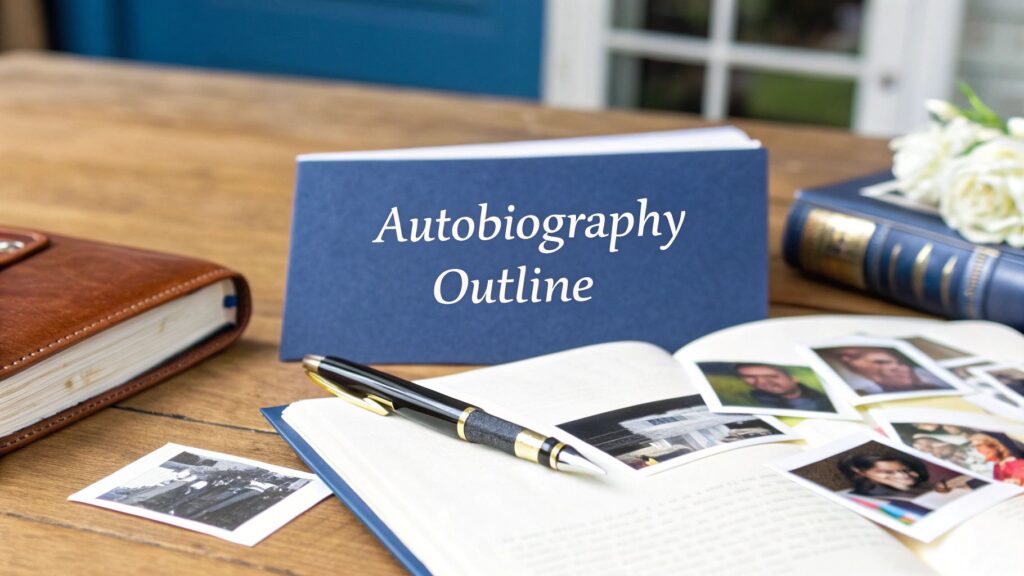A solid autobiography outline is so much more than a simple list of events. Think of it as the architectural blueprint for your life story. It’s where you figure out your core message, who you're actually writing for, and the central theme that will hold everything together. This initial work is what transforms a basic timeline into a story that people can't put down.
Finding the Why Before You Write

Before you even think about chapter breaks or timelines, you have to do the most important work of writing an autobiography: figuring out why you're telling this story. It's a common mistake to just dive in and start listing life events chronologically. But without a clear purpose, a narrative quickly loses steam and feels more like a random collection of memories than a compelling story.
The real goal here isn't to document every single thing you remember. It's to find the thread that ties all your experiences together. What's the one thing you want to leave your reader with? Is your story about resilience, a tough journey to self-acceptance, or maybe about overcoming a very specific challenge? Nailing this down is what gives your life story a true narrative drive.
Defining Your Core Theme
Your core theme is the very soul of your autobiography. It’s the big idea that gives your experiences a deeper meaning and helps readers connect with what you’ve been through. It answers the question: "So, what is this story really about?"
To find your theme, ask yourself a few tough questions:
- What’s the single most important lesson life has taught you?
- If a reader remembers only one thing from your book, what should it be?
- Are there any patterns or recurring challenges that have defined your life?
- What specific moments of change or transformation really stand out?
For instance, a story about building a company from the ground up might have a theme of "perseverance against all odds." An autobiography about moving to a new country could be about "finding where you belong." Once you have your theme, every story and event you choose for your outline should feed back into it.
Your theme is your story's compass. It guides every decision you make—what to include, what to emphasize, and what to leave out—ensuring every piece of the puzzle fits into a powerful, cohesive whole.
Identifying Your Ideal Reader
Just as important as your theme is knowing who you're writing for. Is this a keepsake for your family and grandkids, or are you trying to reach and inspire a broader audience? Your intended reader dramatically shapes your tone, style, and how much context you need to give.
Writing for family means you can use inside jokes and reference shared memories without much explanation. But if you're writing for the general public, you have to fill in the blanks so a complete stranger can step into your world and understand your journey. And believe me, there's an audience for it. The young adult memoir and biography category alone saw a 26% increase in sales revenue in just five years. People are hungry for real, authentic stories. You can find more details on the growth of personal story publishing to see just where your narrative might fit in.
Brainstorming Pivotal Moments and People
Once you have your theme and audience locked in, the brainstorming can begin. Don't worry about chronology just yet; just let the ideas flow. Start making lists of game-changing moments, major turning points, influential relationships, and significant conflicts.
Think in terms of:
- The Highs: Your greatest triumphs, moments of pure joy, and biggest successes.
- The Lows: The times you struggled, failed, or felt heartbroken.
- The Turning Points: Those key decisions that sent your life in a completely new direction.
- The Key People: The mentors, supporters, rivals, and family who shaped you.
This brainstorming session is all about gathering the raw materials for your outline for autobiography. You're essentially excavating your own past, rediscovering connections between different eras of your life and seeing how they all weave together to tell one, central story.
How to Give Your Life Story a Shape
You've figured out what you want to say and who you're saying it to. Now comes the architectural work: building the blueprint for your story. A collection of memories, no matter how fascinating, can feel random without a strong framework. You need a narrative structure that weaves your life's events into a story that feels intentional and keeps readers hooked.
This isn't about shoehorning your experiences into a rigid template. Instead, think of it as choosing the right kind of map for the journey you want to guide your reader on.
Finding the Right Narrative Approach
The most familiar path is a chronological one. You start at the beginning—your childhood—and move forward through time. It’s logical, easy to follow, and a fantastic way to show how you grew and changed over the years. It's the classic "and then this happened" model for a reason.
But sometimes, the most powerful way to tell a story isn't from A to B.
You could throw the reader right into the deep end with a non-linear structure. Imagine starting your book with a pivotal, life-changing moment—a major success, a devastating failure—and then using flashbacks to show the reader exactly how you arrived at that point. This approach creates instant curiosity and is perfect when your entire story hinges on a single, defining event.
Another powerful option is a thematic structure. Instead of following time, you follow an idea. Each chapter could explore a different theme, like "lessons in failure," "the search for belonging," or "mentors who shaped me." This lets you group related memories from all over your life, creating a much richer, more insightful narrative than a simple timeline might allow.
Choosing Your Narrative Structure
Deciding on a structure is a big commitment. It dictates how your readers will experience your life. This table breaks down the core options to help you see which one feels right for the story you need to tell.
| Structure Type | Description | Best For |
|---|---|---|
| Chronological | Events are laid out in the order they happened, from your early years to a specific end point. | Showing gradual growth and development over a lifetime, and drawing clear lines between cause and effect. |
| Non-Linear | You start in media res (in the middle of things) or with a key event, using flashbacks to fill in gaps. | Creating immediate drama and suspense, or focusing the entire story around a central, transformative moment. |
| Thematic | The story is organized around big ideas or motifs (like love, loss, ambition) rather than a timeline. | Exploring deeper meanings and life lessons, especially if a straight chronological tale feels too simple. |
Ultimately, the best structure is the one that serves your core message. Don't be afraid to choose the one that feels most authentic to your experience, even if it's less conventional.
Mapping Out the Major Acts of Your Life
No matter which structure you land on, your outline will still need to touch on the key phases of your life. I like to think of them as the three acts of a play.
Act I: The Foundation
This is all about your roots—where you came from. Go beyond just listing your birthplace. Dig into the environment that shaped your earliest self.
- What was your family dynamic really like?
- What childhood memories offer a glimpse of the person you’d become?
- Who were your first heroes? Or, just as importantly, your first villains?
This is where you plant the seeds of the person the reader will get to know.

Think about how early choices, like those in the infographic, set you on a certain path. The skills and perspectives you gained in your youth are the foundation for everything that comes next.
Act II: The Main Story
This is the meat of your autobiography. It’s your journey through the defining years of your life, where the biggest conflicts, turning points, and achievements happen. If you're looking for a detailed, chapter-by-chapter guide, this book outline example is an excellent resource for fleshing out this crucial middle section.
A great story is fueled by tension. What did you want more than anything? And what—or who—stood in your way? The answers to those two questions are the engine of your life story.
Act III: The Meaning
The final act brings your story home. This isn't just a summary of what happened; it’s where you reflect on what it all meant.
- How have your core beliefs evolved over time?
- What did you truly learn from your greatest challenges?
- What is the legacy you're leaving, or hope to leave?
A powerful ending gives the reader a sense of closure and a clear understanding of your "why." As you organize these big ideas, it’s worth noting that many writers are exploring AI assistance in writing a book to help manage and structure their thoughts. Your outline is the essential first step, ensuring every memory you include serves your story's ultimate purpose.
Weaving Themes into Your Narrative
A truly memorable autobiography is so much more than a play-by-play of your life. It's a story, and great stories have a deeper meaning that connects everything together. While a good structure is the skeleton of your book, themes are its heart and soul. They’re the emotional currents and recurring ideas that make your personal journey feel universal.
This is where your outline for an autobiography transforms from a simple list of events into a powerful storytelling tool. Instead of just noting what happened, you start to explore why it mattered. A theme isn't just a topic; it’s the profound message your experiences reveal about life, struggle, and what it means to be human. It's the difference between saying, "I moved to a new city," and showing a lifelong search for a place to finally call home.
Identifying Your Core Themes
Your life is probably a rich tapestry of different themes that overlap and evolve. The first trick is to actually see them. Go back to the pivotal moments you brainstormed earlier. What are the common threads tying together your greatest achievements, your most painful setbacks, and your biggest turning points?
You’ll likely find some familiar, universal themes running through your life, such as:
- Overcoming Adversity: Stories of fighting back against illness, poverty, or prejudice and coming out stronger on the other side.
- The Search for Belonging: Narratives about finding your tribe—whether in a family, a community, or the world at large.
- Learning to Forgive: The difficult journey of letting go of old hurts, whether forgiving others or, often harder, forgiving yourself.
- Ambition and Its Costs: Exploring that relentless drive for success and the very real sacrifices you made to get there.
- Love and Loss: How the relationships in your life have built you up, challenged you, and fundamentally shaped who you are.
Don't feel like you have to pick just one. The most powerful life stories often weave several themes together. For example, a story about building a business from the ground up (ambition) might also be a story about the relationships that became strained along the way (love and loss).
How to Find Thematic Connections
Once you have a list of potential themes, the real work begins: tracing them through the timeline of your life. This is where you get to be a detective in your own story, connecting dots you might never have noticed before.
Let’s take a simple memory. Say you remember learning to ride a bike when you were seven. On the surface, it’s just a sweet childhood milestone. But if you look a little closer, what else is there?
- Was your father patiently holding the seat for hours? That memory could anchor a theme of family support.
- Did you fall a dozen times but kept getting back up, scrapes and all? That perfectly illustrates a theme of resilience or determination.
- Were you desperately trying to keep up with the older kids on the block? This could tie into a broader theme of the search for belonging.
A single event is rarely about just one thing. By examining key memories from different angles, you can uncover multiple thematic layers, adding incredible depth to your narrative. Your outline shouldn't just list an event; it should also note which of your core themes it reinforces.
Strategically Placing Events in Your Outline
With your themes in hand, you can now use your outline to make them hit home with readers. This isn’t about changing what happened; it’s about arranging the facts to create a powerful narrative arc that resonates emotionally.
Imagine your central theme is "overcoming a fear of failure." You wouldn't just announce that in the introduction and be done with it. Instead, you'd strategically sprinkle key moments throughout your outline to build this theme piece by piece.
- Childhood: You might start with a vivid memory of being laughed at for forgetting your lines in a school play. This plants the seed, showing the reader where that fear came from.
- Young Adulthood: Then, you could detail the time you passed on trying out for the college basketball team or applying for a dream job because you were paralyzed by the thought of not being good enough. This shows the theme's consequences.
- Turning Point: Next, you'd describe the moment you were forced to take a major risk—maybe starting a small business with your last savings—and realized that failure wasn’t the monster you’d imagined.
- Resolution: Finally, you would close with stories that show how you now actively embrace challenges, demonstrating to the reader how you've grown beyond that initial fear.
By intentionally sequencing these events, you aren’t just telling the reader you changed; you're guiding them through that emotional journey. The theme becomes a lived experience they feel right alongside you, turning your outline for an autobiography into a true map of personal transformation.
Bringing Your Story to Life with Narrative Techniques

You’ve got your structure and themes nailed down, which means your outline for an autobiography is more than just a blueprint. It’s the skeleton of your story. Now it’s time to add the flesh and blood—the details that transform a sequence of events into a living, breathing narrative that grabs a reader and doesn't let go.
This is where we shift from what happened to how you tell it. The key is embracing that classic piece of writing advice: "show, don't tell." Instead of saying you were scared, describe your heart hammering against your ribs or the clammy feeling of your palms. This isn’t just a stylistic choice; it’s about pulling your reader directly into your experience.
Painting a Picture with Sensory Language
To make your memories feel tangible, you have to ground them in the senses. Go back to the pivotal moments in your outline and think about what you actually saw, heard, smelled, tasted, and felt.
Let’s say you want to write about your grandmother's kitchen. You could just say it was your favorite place, but that doesn't share the experience. Try this instead:
- Sight: "Sunlight always seemed to find the cracks in the yellow linoleum floor, illuminating the tiny dust motes dancing in the air."
- Smell: "The comforting scent of cinnamon and rising yeast was a constant, a warm promise of fresh bread to come."
- Sound: "I can still conjure the rhythmic thump-thump-thump of her wooden spoon against the side of that heavy ceramic bowl."
See the difference? You’re not just describing a room; you're building a world. You’re inviting the reader to stand right there beside you.
Crafting Authentic Dialogue
Dialogue is one of the most powerful tools in a writer's kit. It’s not just about transcribing what people said—it's about revealing who they are and moving the story forward.
Real people rarely speak in perfectly formed sentences. They interrupt, use slang, trail off, and speak between the lines. Let your dialogue reflect that. Does your mentor get straight to the point? Does your best friend ramble when they get excited? Capturing these unique vocal tics is what makes the people in your life feel like three-dimensional individuals, not just names on a page. Honing this skill is a crucial part of the entire book writing process.
Good dialogue does double duty. It should sound like a real person talking, but it should also subtly reveal something important about their personality, their relationship to you, or the situation itself.
Controlling the Story's Pace and Flow
Pacing is all about rhythm. You are the conductor of your story, and you control the tempo by how you present information. Short, punchy sentences create a sense of urgency and are perfect for high-drama moments. Longer, more lyrical sentences, on the other hand, allow you to slow things down, giving the reader space to absorb a quiet, reflective moment.
A couple of classic techniques can really help you master this:
-
Foreshadowing: Think of this as dropping breadcrumbs for your reader. A subtle mention of a nervous glance, a strange comment, or a recurring object can build incredible suspense and make later revelations feel both surprising and inevitable.
-
Flashbacks: When used well, a flashback can provide critical context or deepen the emotional weight of a scene. The key is to use them with purpose. Jumping around in time too often can disorient your reader, so make sure every trip to the past illuminates something vital in the present narrative.
Mastering these storytelling tools is what separates a personal history from a book people can’t put down. For even more great ideas on bringing your story to life, you can find some additional writing tips on the blog. With global book market projections hitting $155.99 billion by 2030, there’s a clear and growing appetite for powerful stories. Yours could be one of them.
Turning Your Blueprint Into a Masterpiece: How to Refine Your Outline

Think of your first outline draft as a rough sketch. The basic shapes are there, but the real artistry happens during the refinement stage. This isn't just about catching typos; it's about pressure-testing your entire story structure before you invest hundreds of hours into writing the full manuscript.
Getting this part right is the secret to a smoother writing process. A well-polished outline prevents you from writing yourself into a corner and facing months of frustrating rewrites down the line.
Strengthen Your Narrative Arcs
First, take a step back and read your outline from a 30,000-foot view. You're looking for the overall flow of the story. Does your journey make sense? More importantly, does it pack an emotional punch?
Focus on your core narrative arcs—your personal growth, how your relationships evolved, and the central themes you want to convey. Are there any flat spots? For instance, if your theme is "finding resilience," does your outline show a believable progression from struggle to strength, or does it just jump between events without building any real tension? Every single event must earn its place by serving the main story.
An outline isn't just a chronological list of events. It's a strategic map of your emotional journey. If a point on the map doesn't contribute to that journey, it either needs to be reinforced or removed.
Hunt Down and Fill the Gaps
Now it's time to zoom in and look for holes in the story. I call these "narrative gaps"—the missing context that a reader, who hasn't lived your life, will desperately need. To you, the connections are obvious. To them, you need to connect the dots.
As you review each section, ask yourself these questions:
- Is my motivation clear? Does the outline explain why I made a huge decision, or just state that I did?
- Is there enough context? Have I set the scene so the reader understands what was at stake?
- Are the transitions logical? Do I leap from one chapter of my life to the next without explaining the "why" behind the change?
A classic example I see all the time is an outline that says, "Quit my corporate job," immediately followed by, "Moved to Bali." There’s a massive gap there. A refined outline would bridge it with the catalyst: "Felt completely burnt out after the merger," or "A conversation with a mentor made me realize I was on the wrong path." These details are the narrative glue.
How to Get and Use Feedback Without Losing Your Mind
You're simply too close to your own story to spot all its weaknesses. Getting a fresh pair of eyes is probably the single most valuable thing you can do at this stage. But who you ask and how you ask are everything.
Choose just one or two trusted readers—people you know will be honest but also have your back. Don't just hand it over and ask, "So, what do you think?" That’s too vague. Guide them with specific prompts.
A Simple Checklist for Your Reader
- Where did you feel the most hooked?
- Were there any parts where you got confused or your interest started to fade?
- What do you think the main theme of my story is?
- Does my personal growth feel real and earned?
- Was there anything you were surprised not to see included?
When the feedback comes in, take a deep breath and resist the urge to get defensive. Your only job is to listen and look for patterns. If one person is confused by a section, it's something to consider. If both readers flag the same spot, you've found a problem you need to solve.
The goal is to thoughtfully integrate their insights while staying true to your voice. For more general wisdom on the writing process, these tips for writing a book offer some great perspective. This entire polishing stage is about making sure your blueprint is rock-solid before you lay the first brick.
Common Questions About Outlining Your Autobiography
As you start to map out your life story, you'll inevitably run into some questions. That's a good thing—it means you're thinking deeply about how to tell your story effectively. I've heard these same questions from countless writers over the years, so let's walk through some of the most common ones.
How Long Should My Autobiography Outline Actually Be?
There's no magic number here. A solid, truly useful outline usually lands somewhere between 5 and 15 pages. Forget about hitting a specific page count; the real goal is to create a document that genuinely helps you write.
Your outline needs enough detail to be a reliable roadmap for each chapter. It should capture the key scenes, the emotional highs and lows, and the themes you want to weave throughout. At the same time, it can't be so rigid that it breaks when you uncover a forgotten memory or have a new insight. Think of it as a detailed architectural blueprint, not a finished building.
Do I Have to Write My Story in Chronological Order?
Going chronologically is the most popular approach for a reason: it’s clean, logical, and easy for readers to follow. It’s a fantastic way to show your personal growth and the clear cause-and-effect of life events. You can't go wrong with it.
That said, some of the most compelling life stories I've ever read throw the timeline out the window. Many modern memoirs grab you by starting with a dramatic, life-altering moment and then use flashbacks to reveal how the author got there.
The right structure is whatever best serves your story's emotional heart. If your entire narrative hinges on a single, transformative experience, a non-linear approach might build more suspense and captivate the reader far more than a simple A-to-B-to-C timeline.
How Do I Handle Sensitive Topics and Real People?
This is where writing gets tricky. Navigating difficult events and the real people involved demands a lot of thought and ethical care. My best advice is to anchor yourself in one core principle: you are telling your truth from your perspective. No one else can claim authority over your own feelings and experiences.
To protect the privacy of others, it's a widely accepted practice to change names. You can even create composite characters, blending the traits of a few people into a single character. This lets you tell your story with emotional honesty without causing unintended harm.
And when you get to the tough stuff—the painful memories—give yourself permission to just write. Get it all down on the page, raw and unfiltered, for your eyes only. You can decide what you're comfortable sharing with the world later, during the editing process.
What’s the Real Difference Between an Autobiography and a Memoir?
This question trips up so many writers, but understanding the difference can really help you find your focus. It’s simpler than you think.
- An autobiography typically aims to cover the author's entire life from birth to the present, often chronologically. The focus is on documenting a complete personal history.
- A memoir, on the other hand, is more like a snapshot. It zeroes in on a specific period (your years in the military), a recurring theme (your relationship with your father), or a set of related events (your journey to build a business).
Even if you're outlining what feels like your whole life, thinking like a memoirist can be liberating. It pushes you to find the most meaningful and emotionally charged parts of your journey. This focus is what will make your outline for an autobiography—and your final book—truly powerful.
Ready to turn your powerful life story into a professionally published book? The expert team at BarkerBooks is here to guide you every step of the way, from refining your manuscript and designing a stunning cover to distributing your book globally. Learn more about how BarkerBooks can help you achieve your publishing dreams.
